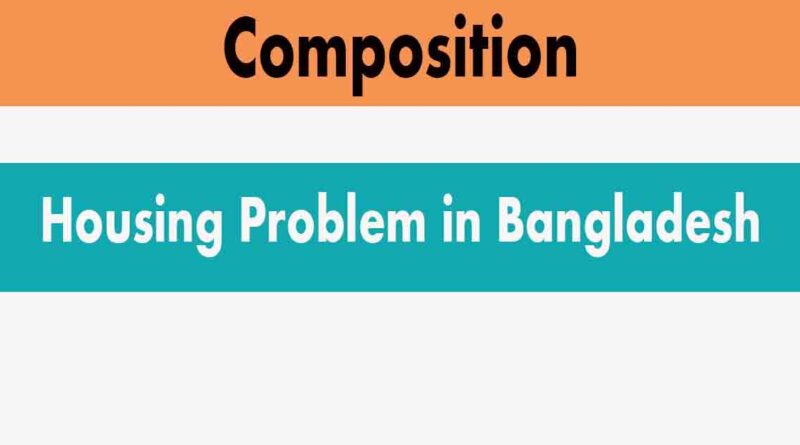Housing Problem in Bangladesh Composition
Introduction: A house is a place where a person lives. The house can be used for other purposes, but usually for living
Necessity of a house: Housing is one of the basic human needs. A man needs a house to keep body and soul together. We live in houses to protect ourselves from heat and cold.
Houses also protect us from rain and storms. Some people need houses to protect themselves from floods and wild animals. Homes keep us comfortable and happy.
But the irony is that a large number of people in Bangladesh do not have their own house. House of different sizes and shapes: In Bangladesh, houses are not alike. There are houses of various sizes and shapes.
Some are big, some are small. Some houses have only one room. Some have many. The roofs of some are quickly disappearing. the houses are flat while the other houses are sloping. People make roofs slanted to let rainwater through.
Materials for building houses: In Bangladesh, houses are made of different things. People here build their houses out of whatever they can easily get. In the villages, most people build their houses from bamboo, ropes, straw and mud. The wealthier part of people build houses from corrugated iron. To build such a house, we need sheets of corrugated iron, wood, nails and screws.
Various problems in housing: The first thing that is needed to build a house is money. But the majority of our people are poor and many of them do not have money to build houses to live in. Moreover, many poor people are landless. They don’t have land to build houses on. So a certain percentage of our population is not only poorly fed and clothed, but also homeless.
To provide a dwelling house to a huge population has become a Herculean task that defies all attempts at solution. Secondly, floods visit our country almost every year. Floodwaters wash away damage to many homes every year.
The flood alone between 1988 and 1998 completely devastated 47 million houses and partially damaged 93 million houses. Thirdly, many people living along the mighty Padma, Meghna and Yamuna lose their homes due to the strong current and waves of these rivers. Fourth, due to the enormous consumption of firewood for cooking, our forests are losing so many trees that there is an acute shortage of wood and wood needed for building houses.
Fifth, the problems have become more acute in urban areas. Service owners spend a significant portion of their earnings on accommodation. A significant proportion of the homeless live in makeshift slums, on the streets, at railway stations and in railway carriages.
Composition:- Good Manners composition
Housing Problem in Bangladesh Composition For Hsc
Introduction: Bangladesh, a densely populated country in South Asia, faces a significant housing problem that has far-reaching consequences for its citizens. With rapid urbanization, a burgeoning population, and limited resources, the country grapples with various challenges related to housing. This composition delves into the housing problem in Bangladesh, shedding light on its root causes, consequences, and potential solutions.
Root Causes of the Housing Problem:
Overpopulation: Bangladesh is one of the most densely populated countries globally, with approximately 165 million people living within its borders. This population density exacerbates the housing issue, leading to overcrowding and a shortage of affordable housing options.
Rapid Urbanization: The country has experienced rapid urbanization in recent years, with people migrating from rural areas to cities in search of better opportunities. This influx has put immense pressure on urban housing infrastructure, leading to slum development and inadequate housing conditions.
Limited Land Resources: Bangladesh is a relatively small country with limited land resources. The scarcity of available land for housing construction drives up property prices, making it unaffordable for many low-income individuals and families.
Inadequate Urban Planning: The lack of effective urban planning and zoning regulations has resulted in haphazard and unplanned urban growth. This has led to the emergence of informal settlements and slums without access to basic amenities.
Consequences of the Housing Problem:
Substandard Living Conditions: Many people in Bangladesh live in substandard housing conditions, characterized by overcrowding, lack of sanitation facilities, and inadequate infrastructure. These conditions pose serious health and safety risks to residents.
Spread of Slums: The housing problem has contributed to the proliferation of slums in urban areas. These slums are often located in high-risk areas prone to natural disasters, putting their inhabitants in precarious situations.
Social Inequity: The housing issue exacerbates social inequities, as access to quality housing is often determined by income levels. Low-income families struggle to find decent housing options, perpetuating the cycle of poverty.
Environmental Impact: Unplanned urbanization and inadequate housing infrastructure have negative environmental consequences, such as increased pollution, deforestation, and strain on natural resources.
Potential Solutions:
Affordable Housing Initiatives: The government and private sector can collaborate to develop affordable housing projects targeting low and middle-income families. Subsidies, microfinance programs, and incentives for developers can promote the construction of affordable housing units.
Improved Urban Planning: Strengthening urban planning and zoning regulations can help manage urban growth effectively. This includes identifying suitable areas for housing development, improving infrastructure, and preventing illegal encroachments.
Slum Upgrading Programs: Implementing slum upgrading programs can improve living conditions in informal settlements. This includes providing access to clean water, sanitation facilities, and electricity.
Disaster-Resilient Housing: Given Bangladesh’s vulnerability to natural disasters, promoting the construction of disaster-resilient housing can enhance the safety of vulnerable communities.
Awareness and Education: Public awareness campaigns and education initiatives can inform citizens about their housing rights and available resources, empowering them to seek better housing solutions.
Conclusion: The housing problem in Bangladesh is a multifaceted challenge with profound social, economic, and environmental implications. Addressing this issue requires a concerted effort from the government, private sector, and civil society to ensure that all citizens have access to safe and affordable housing.
Implementing a combination of policies, such as affordable housing initiatives, improved urban planning, and slum upgrading programs, can help alleviate the housing problem and improve the quality of life for millions of Bangladeshis.




